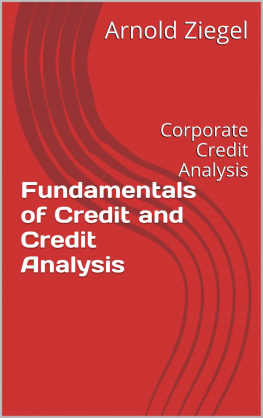Ziegel - Fundamentals of Credit and Credit Analysis
Here you can read online Ziegel - Fundamentals of Credit and Credit Analysis full text of the book (entire story) in english for free. Download pdf and epub, get meaning, cover and reviews about this ebook. year: 2015, publisher: Unknown, genre: Business. Description of the work, (preface) as well as reviews are available. Best literature library LitArk.com created for fans of good reading and offers a wide selection of genres:
Romance novel
Science fiction
Adventure
Detective
Science
History
Home and family
Prose
Art
Politics
Computer
Non-fiction
Religion
Business
Children
Humor
Choose a favorite category and find really read worthwhile books. Enjoy immersion in the world of imagination, feel the emotions of the characters or learn something new for yourself, make an fascinating discovery.
Fundamentals of Credit and Credit Analysis: summary, description and annotation
We offer to read an annotation, description, summary or preface (depends on what the author of the book "Fundamentals of Credit and Credit Analysis" wrote himself). If you haven't found the necessary information about the book — write in the comments, we will try to find it.
Ziegel: author's other books
Who wrote Fundamentals of Credit and Credit Analysis? Find out the surname, the name of the author of the book and a list of all author's works by series.
Fundamentals of Credit and Credit Analysis — read online for free the complete book (whole text) full work
Below is the text of the book, divided by pages. System saving the place of the last page read, allows you to conveniently read the book "Fundamentals of Credit and Credit Analysis" online for free, without having to search again every time where you left off. Put a bookmark, and you can go to the page where you finished reading at any time.
Font size:
Interval:
Bookmark:

Corporate Credit Analysis
Arnold Ziegel
Mountain Mentors Associates
Text copyright 2014 Arnold Ziegel
Mountain Mentors Associates
All Rights Reserved
Table of Contents
Fundamentals of Credit and Credit Analysis
Introduction The Goals and Nature of Credit Analysis
Capital Structure and Debt Capacity
Fundamentals of Financial Analysis
Credit, Risk, Cash Flow, and Capital Structure
Principles of Extending Credit - Consumer Credit, Corporate
Credit, and Financial Institution Credit
Cash Flow Analysis and Forecasting
The Process of Credit Analysis - Making Credit Decisions
Use of Credit Structure to Modify Risk
Commercial Finance and Structured Finance
Managing Credit Risk - Risk Ratings and Portfolio Management
Arnold Ziegel formed Mountain Mentors Associates after his retirement from a corporate banking career of more than 30 years at Citibank. The lessons learned from his experience in dealing with entrepreneurs, multinational corporations, highly leveraged companies, financial institutions, and structured finance, led to the development and delivery of numerous senior level credit risk training programs for major global financial institutions from 2002 through the present.
This book was conceived and written as a result of the development of these courses and his experience as a corporate banker. It illustrates the fundamental issues of credit and credit analysis in a manner that tries to take away its mystery. The overriding theme of this book is that when an investor extends credit of any type, the goal is to get your money back, and with a return that is commensurate with the risk.
The goal of credit analysis is not to make yes or no decisions about the extension of credit, but to identify the degree of risk associated with a particular obligor or a particular credit instrument. This is consistent with modern banking industry portfolio management and the rating systems of credit agencies. Once the riskiness of an obligor or credit instrument is established, it can be priced or structured to match the risk demands or investment criteria of the entity that is extending the credit.
A simple quote from Mr. J. P. Morgan is used often in this text - Lending is not based primarily on money or property. No sir, the first thing is character. This statement represents one of the conflicts in modern credit analysis that of models for decision making versus traditional credit analysis. The 2008 financial crisis was rooted in the mortgage backed securities business. Sophisticated models were used by investors, banks, and rating agencies to judge the credit worthiness of billions (and maybe trillions) of dollars worth of residential mortgage loans that were packaged into securities and distributed to investors. The models indicated that these securities would have very low losses.
Of course, huge losses were incurred. Mr. Morgan had a good point. In this case is was both property and character. The properties that were the collateral for many of the mortgages had much less value than was anticipated. The valuation of the collateral was nave and flawed. Many assumptions were made that the value of homes would rise without pause. Many mortgage loans were made that were at or even above the appraised value of a residence.
But character was a huge, perhaps larger, factor behind these losses. Many of the residential mortgage loans were made to individuals who knew that they did not have the income to make the required payments on the mortgages. Many of the mortgage brokers and lenders who made these loans also knew that many of the borrowers were not properly qualified. And, many of the bankers who securitized these loans also may have doubted the credit quality of some of the underlying mortgages. If bankers and rating agencies understood the extent of the fraud and lax standards in the fundamental loans backing the mortgage securities, or were willing to acknowledge it, the fiasco would not have occurred.
Thanks are due to Keith Waitt of Consultancy Matters, who encouraged and facilitated the development of these credit risk training programs; and Ronna Ziegel, Ph.D., who established the basis for the teaching philosophy and techniques.
Arnold Ziegel
Mountain Mentors Assocates
Stowe, Vermont
2014
Introduction The Goals and Nature of Credit Analysis
Credit analysis is an art, not a science. The goal of credit analysis is to make a judgment about an obligors ability and willingness to pay back what it owes, when it is owed. Obligations could be a loan, bond, trade payable, or any kind of financial contract.
The fundamental question that a credit analyst needs to answer is: what is the degree of risk that an obligor will have sufficient cash to pay back an obligation when it is due? If the obligation is short term, and the obligor has a lot of liquidity, the answer is usually easy to determine.
If the time frame is longer, the answer to this question is not easy. The credit analyst must assess the factors that will impact an obligors ability to pay in the future, including the willingness to pay. The basis for this assessment is the prediction of future cash flow, future liquidity, and capital structure.
In order to make a judgment about the degree to which cash will be able to fulfill an obligation in the future, the credit analyst must be able to project future cash flow, and make an assessment about the risks associated with that projection. Analysis of historical financial performance is usually the starting point for the estimates of future performance. Assessing the capital structure relative to the operating risks is a critical indicator of the degree of financial risk that the obligor is incurring. But, financial analysis must be supported by the logic of assessing business strategy and industry key success factors. Events dont happen by themselves assessing management capability is also critical to the forecasting process.
Judgments must be made about the forecasts of future performance relative to history, future capital structure, management capability, business strategy, competitors performance and competitive pressure, and the macro-economic environment. If the future revenue generation of the obligor is risky, due to the nature of the business, the strategy, and environment (i.e., it has high operating risk), then the capital structure should be relatively conservative. If future revenue and cash flow seems to be stable with little risk, then the capital structure can have higher degrees of leverage and financial risk.
Equity analysts try to estimate the value of a company.
Credit analysts try to establish the degree to which an obligor can fulfill the terms of its debt obligations short term and long term
Both equity analysis and credit analysis require the use of significant judgment to assess future performance and future cash flow.
Estimates of future cash flow are the basis for all securities valuation equity and debt.
The art of both equity and credit analysis rests upon the understanding of the many factors that can impact future cash flow, and making judgments about those factors. While the value of equity may be enhanced by the use of a lot of debt (leverage), this adds risk to the creditors of the obligor. At some point, high degrees of leverage can substantially increase the risk of bankruptcy. Finding the balance between operating risk (business risk) and financial risk (capital structure) is a key element of the role of the credit analyst.
Font size:
Interval:
Bookmark:
Similar books «Fundamentals of Credit and Credit Analysis»
Look at similar books to Fundamentals of Credit and Credit Analysis. We have selected literature similar in name and meaning in the hope of providing readers with more options to find new, interesting, not yet read works.
Discussion, reviews of the book Fundamentals of Credit and Credit Analysis and just readers' own opinions. Leave your comments, write what you think about the work, its meaning or the main characters. Specify what exactly you liked and what you didn't like, and why you think so.











